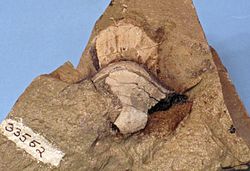| Petalodus Temporal range: | |
|---|---|
 | |
| P. ohioensis tooth | |
| Scientific classification | |
| Kingdom: | Animalia |
| Phylum: | Chordata |
| Class: | Chondrichthyes |
| Subclass: | Holocephali |
| Order: | † Petalodontiformes |
| Family: | † Petalodontidae |
| Genus: | † Petalodus Owen, 1840 |
| Type species | |
| †Petalodus hastingsii | |
| Other species | |
| |
| Synonyms | |
| |
Petalodus is an extinct genus of cartilaginous fish from the Pennsylvanian to the Permian, [6] [7] known from subtriangular to rhomboidal teeth. [7] The genus was named by Richard Owen in 1840 and the type species is Petalodus hastingsii. [1] [2] [3] [4] The only dubious species within this genus is P. securiger. [8] [9]






